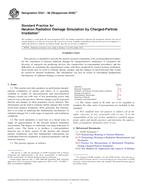Potřebujeme váš souhlas k využití jednotlivých dat, aby se vám mimo jiné mohly ukazovat informace týkající se vašich zájmů. Souhlas udělíte kliknutím na tlačítko „OK“.
ASTM E521-96(2009)e1
Standard Practice for Neutron Radiation Damage Simulation by Charged-Particle Irradiation (Includes all amendments And changes 10/26/2015).
Automaticky přeložený název:
Standardní praktiky pro Neutron radiačního poškození simulace nabitých částic ozáření
NORMA vydána dne 1.8.2009
Informace o normě:
Označení normy: ASTM E521-96(2009)e1
Poznámka: NEPLATNÁ
Datum vydání normy: 1.8.2009
Kód zboží: NS-47083
Počet stran: 21
Přibližná hmotnost: 63 g (0.14 liber)
Země: Americká technická norma
Kategorie: Technické normy ASTM
Anotace textu normy ASTM E521-96(2009)e1 :
Keywords:
accelerators, beam heating, charged particle irradiation, damage calculations, dosimetry, transmission electron microscopy, ion irradiation, metallography, microstructure, radiation damage correlation, radiation damage simulation, void swelling, ICS Number Code 27.120.10 (Reactor engineering)
Doplňující informace
| Significance and Use | ||||||||||||||||
|
A characteristic advantage of charged-particle irradiation experiments is precise, individual, control over most of the important irradiation conditions such as dose, dose rate, temperature, and quantity of gases present. Additional attributes are the lack of induced radioactivation of specimens and, in general, a substantial compression of irradiation time, from years to hours, to achieve comparable damage as measured in displacements per atom (dpa). An important application of such experiments is the investigation of radiation effects in not-yet-existing environments, such as fusion reactors. The primary shortcoming of ion bombardments stems from the damage rate, or temperature dependences of the microstructural evolutionary processes in complex alloys, or both. It cannot be assumed that the time scale for damage evolution can be comparably compressed for all processes by increasing the displacement rate, even with a corresponding shift in irradiation temperature. In addition, the confinement of damage production to a thin layer just (often ∼ 1 μm) below the irradiated surface can present substantial complications. It must be emphasized, therefore, that these experiments and this practice are intended for research purposes and not for the certification or the qualification of equipment. This practice relates to the generation of irradiation-induced changes in the microstructure of metals and alloys using charged particles. The investigation of mechanical behavior using charged particles is covered in Practice E 821. |
||||||||||||||||
| 1. Scope | ||||||||||||||||
|
1.1 This practice provides guidance on performing charged-particle irradiations of metals and alloys. It is generally confined to studies of microstructural and microchemical changes carried out with ions of low-penetrating power that come to rest in the specimen. Density changes can be measured directly and changes in other properties can be inferred. This information can be used to estimate similar changes that would result from neutron irradiation. More generally, this information is of value in deducing the fundamental mechanisms of radiation damage for a wide range of materials and irradiation conditions. 1.2 The word simulation is used here in a broad sense to imply an approximation of the relevant neutron irradiation environment. The degree of conformity can range from poor to nearly exact. The intent is to produce a correspondence between one or more aspects of the neutron and charged particle irradiations such that fundamental relationships are established between irradiation or material parameters and the material response. 1.3 The practice appears as follows:
1.4 The values stated in SI units are to be regarded as standard. No other units of measurement are included in this standard. 1.5 This standard does not purport to address all of the safety concerns, if any, associated with its use. It is the responsibility of the user of this standard to establish appropriate safety and health practices and determine the applicability of regulatory limitations prior to use. |
||||||||||||||||
| 2. Referenced Documents | ||||||||||||||||
|
Odebírejte informace o nově vydaných normách ZDARMA:
Chcete pravidelně odebírat informace o nově vycházejících normách z celého světa a to zcela zdarma?
Přihlašte se k odběru. Vše je velice jednoduché a absolutně ZDARMA.
Na výběr máte vydavatele z celého světa.




 Cookies
Cookies
